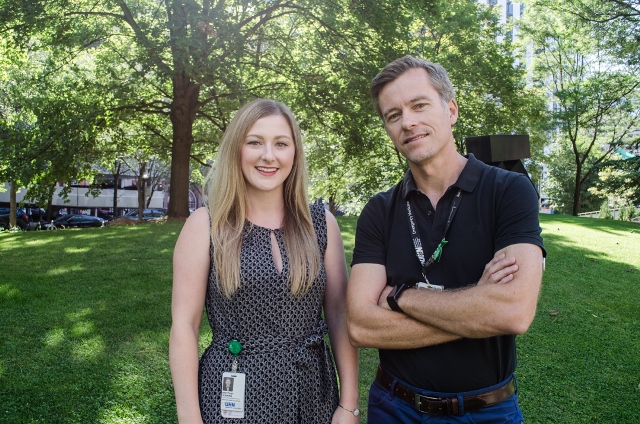
By Jasmine Sikand
Arriving at a hospital Emergency Department (ED), patients may expect to be asked their medical condition and history as a way to give treating clinicians an accurate diagnosis.
Until recently, none of those initial screening questions asked in the ED at UHN included an assessment of a patient’s mental health.
But a pair of advanced practice nurse educators (APNE) have helped change that.
Record forms in the ED at Toronto General (TG) and Toronto Western (TW) hospitals, as well as the Urgent Care Clinic at Princess Margaret Cancer Centre (PM), now include questions that screen for mental health, including suicide.
“As nurses, our responsibility is to do a comprehensive assessment of our patient,” says Brittany Jenkins, APNE at TW ED, who drove the changes along with Stephen Casey, APNE at TG ED. “If we can identify a problem early on, we can escalate to the physician or get the proper supports in place.”
Toronto Rehab’s (TR) Bickle Centre also recently began using a screening tool, which is specific to suicide risks, in two of their inpatient units. Used once every 24 hours, the results are entered into a nursing documentation form.
An escalation algorithm developed in collaboration with Bickle physicians accompanies the screening tool, and assists nurses with decision-making about interventions related to high-risk patients.
UHN is unique in having PESU (Psychiatric Emergency Services Unit) within the ED at TW, which many other hospitals don’t have. PESU takes over the care of any patient in the ED with mental health issues. However, all patients still come through the main EDs, and their primary assessments are typically completed there.
“We often have patients who don’t come in for a mental health complaint, but issues with their mental health may still be affecting their everyday life, or be a factor in the condition they did come to the ER for,” Stephen says. “In the ED, we are in a prime position to not only identify, but connect these patients with the mental health services and the care they require to avoid possible harm.”
The new nursing record forms were implemented in June, with the help of a project team comprised of Kristen Cunningham, Senior Planner of Strategy and Transformation at UHN; Kelsey Hannon, Product Designer at Healthcare Human Factors; Maggie Dilling, APNE at PM Urgent Care Clinic; and Brittany and Stephen.
Dr. Justin Delwo, Medical Lead of Mental Health Emergency Services at TW, supports the initiative and hopes to see more inclusion of mental health in the future. “It is so important to be inclusive of mental health in all areas to provide seamless care for our patients and ensure we really are providing the care our patients need,” says Dr. Delwo.
At Bickle, planning for the tool began in April and education started on a pilot unit in August. It is currently used by nurses, but it’s hoped that in the coming months Allied Health Professionals will be trained and it will be expanded to all other units at the site.
Casey at TG says nursing staff are generally excited about the new form, but there is some discomfort in asking the questions to all patients, especially if a patient is coming in for an issue seemingly unrelated to mental health. Some of this discomfort stems from nursing staff being unfamiliar with mental health patients, as not all have had mental health training in nursing school.
“There is still such a stigma around it. We need to be able to feel comfortable to ask these questions so people can talk about it, because if they’re not bringing it up and we’re not bringing it up, how can we fully help these patients and give them the support they need?” Brittany says.
What helps to make nurses more comfortable is including guiding questions on the form? Brittany says staff are advised to ask at least the first two questions to patients – whether they are having any present thoughts of self-harm or any present thoughts of harm to others – and then depending on their answers, proceed accordingly.
“It’s really about reminding staff that those questions should be asked in the exact same manner you would ask patients any other question, and that we are not just asking these questions to patients who come in with depression or situational crisis,” Brittany says.
In addition to being able to better help the patient while in hospital, Stephen says the mental health and suicide screening gives staff the opportunity to educate patients about community resources they may never have known of before in the event they are experiencing some mental health issues.
Jasmine Sikand is a Communications Coordinator at the University Health Network’s Centre for Mental Health.


